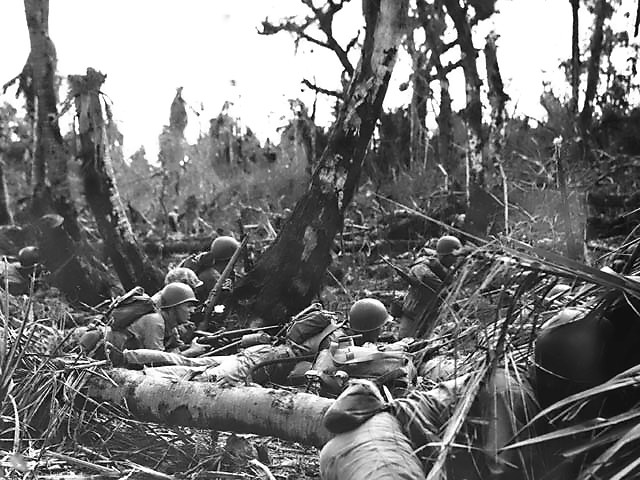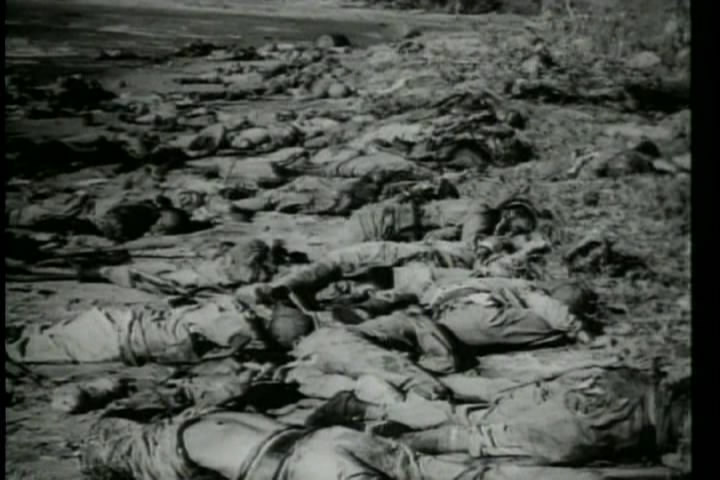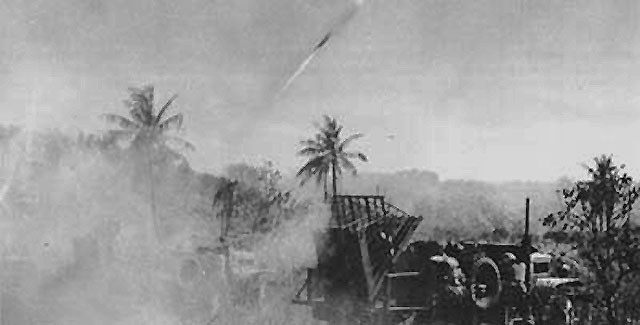| Battle for Saipan, Part Twelve
By David H. Lippman
May 2014
You can read Part Eleven here.
The Americans knew something was coming. An hour after dark on the 6th, a GI patrolling the road near the command post of 3rd/105th came upon a lone, armed Japanese lying asleep. The sleeping Japanese got a rude awakening, but was hauled off alive to the command post for interrogation. He turned out to be a Leading Seaman of the Navy’s 55th Guard Force.
A weakness of the Japanese armed forces was field security, and many junior enlisted were often privy to the details of their bosses’ plans. This seaman was persuaded to open up, and he revealed that the Japanese were planning an all-out attack before dawn by everyone who could carry a rifle or spear.
The warning rocketed up the chain of command straight to Holland Smith, who took no chances. He ordered the 27th to be ready for a pre-dawn assault, and 1st/105th and 2nd/105th awaited the attack.

Marines prepare to meet the Japanese attack.
The Japanese hit the Americans with full force. Lt. George O’Donnell, of G Company, 2nd/105th, described the attack in a letter home to his parents: “At about 0430 all hell broke loose! It was their big Banzai attack out from the draw, below us, the two remaining Jap tanks, followed by about 400 Japs heading for the flats below us. It had just finished pouring, and we were all soaked, with our teeth chattering. But no sooner had we dropped our eyes on that mob, than we forgot all our discomforts! And then, from our right and below us, there came thousands of Japs! For two hours they passed by, and came right at us. It was like a mob after a big football game, all trying to get us at once! We had a hard struggle keeping them from overrunning us, and we had a field day, firing, firing, until our ammunition started to run low. The closest any of them came was 10 yards; and we were hitting them at 400 and 500 yards also.”
To Maj. Edward McCarthy, commanding 2nd/105th, the Japanese attack “was like the movie stampede staged in the old Wild West movies. We were the cameramen. The Japs just kept coming and coming and didn’t stop. It didn’t make any difference that you shot one; five more would take his place. We would be in foxholes looking up, just like those cameramen used to be. The Japs ran right over us.”
The Japanese stormed forward, the men in the front rank holding forward red flags to rally the attackers. Japanese troops screamed “Banzai!” and “Seven Lives for the Fatherland!”

Seven lives for the Fatherland.
Leading his 1st/105th, Lt. Col. William O’Brien, a native of Troy, New York, stood his ground in the front lines, firing pistols with both hands to inspire his men. He was seriously wounded, but refused to be evacuated. When he emptied his pistols’ clip, he manned a .50-caliber machine-gun mounted on a jeep. “When last seen alive, he was standing upright firing into the Jap hordes that were enveloping him. Some time later his body was found surrounded by enemy he had killed,” the citation of his posthumous Medal of Honor concluded. He was buried in St. Peter’s Cemetery in Troy.
Another Troy native, Cpl. Thomas A. Baker, of A Company, 1st/105th, was seriously wounded, but refused to be evacuated, firing at Japanese troops as close as five yards away. “Without ammunition and with his own weapon battered to uselessness from hand-to-hand combat, he was carried about 50 yards to the rear by a comrade, who was then himself wounded. At this point Cpl. Baker refused to be moved any farther stating that he preferred to be left to die rather than risk the lives of any more of his friends. A short time later, at his request, he was placed in a sitting position against a small tree. Another comrade, withdrawing, offered assistance. Cpl. Baker refused, insisting that he be left alone and be given a soldier’s pistol with its remaining eight rounds of ammunition. When last seen alive, Cpl. Baker was propped against a tree, pistol in hand, calmly facing the foe. Later Sgt. Baker’s body was found in the same position, gun empty, with eight Japanese lying dead before him,” read his citation for the Medal of Honor, awarded posthumously (along with a promotion to sergeant). He was buried in a National Cemetery in Schuylerville, New York.
The Japanese stormed over the two defending Army battalions, killing or wounding 650 GIs. Another group of Japanese troops stormed through a winding canyon and into the 3rd Battalion, but these Americans were too well emplaced, and could not be dislodged.
In the 2nd/105th’s sector, Army dentist Capt. Ben Salomon, of Wisconsin, was working at the battalion aid station, replacing the wounded battalion surgeon, when the Japanese charged the hospital
“As the perimeter began to be overrun, it became increasingly difficult for Captain Salomon to work on the wounded. He then saw a Japanese soldier bayoneting one of the wounded soldiers lying near the tent. Firing from a squatting position, Captain Salomon quickly killed the enemy soldier. Then, as he turned his attention back to the wounded, two more Japanese soldiers appeared in the front entrance of the tent. As these enemy soldiers were killed, four more crawled under the tent walls. Rushing them, Captain Salomon kicked the knife out of the hand of one, shot another, and bayoneted a third. Captain Salomon butted the fourth enemy soldier in the stomach and a wounded comrade then shot and killed the enemy soldier. Realizing the gravity of the situation, Captain Salomon ordered the wounded to make their way as best they could back to the regimental aid station, while he attempted to hold off the enemy until they were clear. Captain Salomon then grabbed a rifle from one of the wounded and rushed out of the tent. After four men were killed while manning a machine gun, Captain Salomon took control of it. When his body (with 76 bullet wounds) was later found, 98 dead enemy soldiers were piled in front of his position,” read the citation for Salomon’s posthumous Medal of Honor, the third awarded to an Army dentist.
The medal itself would not be presented until 2002. When the 27th Division’s historian, Capt. Edmund G. Love, who was among those who found the body, wrote up the incident he recommended the Medal of Honor for Salomon. But Gen. Griner, the new division commander, shot it down because Salomon by firing his weapon had violated his role as a noncombatant. Perhaps more to the point, Salomon was Jewish – only two Jews received the Medal of Honor during or immediately after World War II.
In 1951, Love re-filed his paperwork and was shot down again; it was past the time limit for such recommendations. In 1970, the Army’s Surgeon General again requested the Medal of Honor for Salomon, but the recommendation was not acted upon. Finally, in 1998, Dr. Robert B. West, of USC Dental School – Salomon’s alma mater – filed a new request through his Congressman, Brad Sherman. In it, he noted that the Geneva Convention, while barring doctors from using “crew-served” weapons, did allow them to use personal weapons in self-defense. While normally a machine-gun was a “crew-served” weapon, Salomon had clearly manned it alone. On May 1, 2002, President George W. Bush presented the Medal of Honor, and Dr. West accepted it on behalf of the USC Dental School, where it is displayed.

Marine rocket trucks, the original "shoot-n-scoot."
As the Japanese attack flowed south, Marine artillery deployed behind the GIs opened fire, knocking out a Japanese tank, but the enemy stormed through to the gunners’ emplacements.
“It was 5:15,” Lt. Arnold Hostetter of Battery H recalled, “just getting light, when a group of men were seen advancing on the battery position from the right front at about 600 yards. It was thought that Army troops were somewhere to the front, so fire on this group was held until they were definitely identified as Japanese at about 400 yards. We knew that our men manning listening posts were somewhere to our front so the firing battery was ordered to open fire with time and ricochet fire on the group to the right. Firing was also heard from the machine guns on the left.”
“The artillery men fired point blank into the Japs with fuses set at four-tenths of a second” Robert Sherrod reported for Time magazine. “They bounced their high explosive shells 50 yards in front of the guns and into the maniacal ranks.”
The 27th Division’s artillery joined the battle, hurling 2,666 shells at the Japanese, averaging 40 rounds a minute. But the Marine artillerymen were forced to withdraw and their battalion commander, Maj. William L. Crouch, was killed. Battery H left their breechblocks and firing locks in their howitzers, but Battery I’s men had time to remove their firing locks before falling back into a Japanese aircraft parts depot nearby. The depot was filled with crates, boxes, wings, and fuselages, and the adaptable Leathernecks used them to build an instant fort. Armed with pistols and grenades, Marines turned back the Japanese attack, leaving dead Japanese in front of their makeshift fort. When the Japanese retreated, the Marines leaped out and grabbed rifles and swords from the dead Japanese. When the Japanese counterattacked, it produced one of the most bizarre sights of the entire war: Japanese and American troops fighting to the death with samurai swords.
A shorter version of this appeared in the February 2014 issue of WW2 History magazine, published by Sovereign Media, and is used with permission.
David H. Lippman, an award-winning journalist
and graduate of the New School for Social Research,
has written many magazine articles about World
War II. He currently works
as a public information officer for the city
of Newark, N.J. We're always pleased to add his work
to our Daily Content.
|
